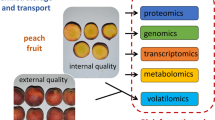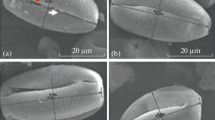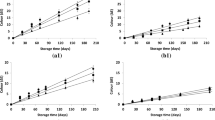Abstract
Abiotic changes in fruits which are associated with climatic or management practices are known as physiological disorders. These are commonly found in temperate fruits during their development on the tree and during storage. The disorders can be found in storage also without having any trace of them during the developmental stages of the fruit. Stone fruits which comprise peach, nectarines, plum, apricot and cherry are greatly affected by the occurrence of the physiological disorders which reduce their consumer acceptability and market value. Temperate fruit develops many physiological disorders during their developmental stages with all of them exhibiting particular symptoms. However, the processes involved in the development of these disorders have not been completely understood as of now. Some of the commonly observed physiological disorders in stone fruits are internal breakdown, gummosis, split and shattered pits, fruit discoloration, gel breakdown and pit burning in apricots, fruit cracking in cherry, etc. Proper identification, understanding the biology and correction measures like adaption of resistant varieties and proper cultural practices will help the farmers in reducing the losses due to these disorders.
Access this chapter
Tax calculation will be finalised at checkout
Purchases are for personal use only
Similar content being viewed by others
References
Anonymous. (2020). Physiological disorders. Retrieved from http://kare.ucanr.edu/programs/Postharvest_for_ fruits_ and_nuts/Physiological_disorders/.
Artlip, T. S., Callahan, A. M., Bassett, C. L., & Wisniewski, M. E. (1997). Seasonal expression of a dehydrin gene in sibling deciduous and evergreen genotypes of peach (Prunus persica [L] Batsch). Plant Molecular Biology, 33, 61–70.
Beppu, K., Ikeda, T., & Kataoka, I. (2001). Effect of high temperature exposure time during flower bud formation on the occurrence of double pistils in ‘Satonishiki’ sweet cherry. Scientia Horticulturae., 87, 77–84.
Beppu, K., & Kataoka, I. (2011). Studies on pistil doubling and fruit set of sweet cherry in warm climate. Journal of Japanese Society for Horticultural Science., 80, 1–13.
Beppu, K., Sumida, H., & Kataoka, I. (2015). Cloning and characterisation of APETALA3-like and PISTILLATAlike B class MADS-box genes from sweet cherry. Journal of Applied Horticulture, 17(2): 87-91
Brovelli, E. A., Brecht, J. K., Sherman, W. B., & Sims, C. A. (1999). Anatomical and physiological responses of melting- and nonmelting-flesh peaches to postharvest chilling. Journal of American Society for Horticultural Science, 123, 668–674.
Brummell, D. A., Dal Cin, V., Lurie, S., Crisosto, C. H., & Labavitch, J. M. (2004). Cell wall metabolism during the development of mealiness in cold-stored peach fruit: 494 association of mealiness with arrested disassembly of cell wall pectins. Journal of Experimental Botany, 55, 2041–2052.
Brummell, D. A. & Harpster, M. H. (2001). Cell wall metabolism in fruit softening and quality and its manipulation in transgenic plants. Plant Molecular Biology, 47, 311–339
Byers, R. E. (1997). Peach and nectarine fruit softening following Aminoethyoxyvinylglycine sprays and dips. Hortscience, 32, 86–88.
Callahan, A. M., Scorza, R., Bassett, C., Nickerson, M., & Abeles, F. B. (2004). Deletions in an endopolygalacturonase gene cluster correlate with non-melting flesh texture in peach. Functional Plant Biology, 31, 159–168.
Chamberlain, E. E., Atkinson, J. D., & Hunter, J. A. (1959). Two diseases of plum causing distortion and internal necrosis of fruits. New Zealand Journal of Agricultural Science, 2, 174–183.
Cheng, G. W., & Crisosto, C. H. (1994). Development of dark skin discolouration of peach and nectarine fruits in response to exogeneous contaminations. Journal of American Society of Horticultural Science, 11, 529–533.
Christensen, J. V. (1972). Cracking in cherries III. Determination of cracking susceptibility. Acta Agriculturae Scandinavica, 22, 128–136.
Christensen, J. V. (1996). Rain-induced cracking of sweet cherries: Its causes and prevention. In A. D. Webster & N. E. Looney (Eds.), Cherries: Crop physiology, production and uses (pp. 297–330). London: CAB International.
Chunxian, C., William, R. O., & Thomas, G. B. (2016). Peach fruit set and buttoning after spring frost. HortScience, 51(7), 816–821.
Corrons, C. H. (1922). Plant breeding. A summary of results. Proceeding of American Society of Horticultural Science, 19, 108–115.
Crisosto, C., Johnson, R. S., Luza, J., & Day, K. (1993). Incidence of physical damage on peach and nectarine skin discoloration development: Anatomical studies. Journal of American Horticultural Science, 118, 796–800.
Crisosto, C. H., & Day, K. R. (2012). Stone fruits. In Crop post-harvest: Science and technology (pp. 212–225). Oxford: Black Well.
Crisosto, C. H., & Labavitch, J. M. (2002). Developing a quantitative method to evaluate peach (Prunus persica) flesh mealiness. Postharvest Biology and Technology, 25, 151–158.
Crisosto, C. H., Lurie, S., & Retamales, J. (2008). Stone fruits. In Modified and controlled atmosphere (pp. 287–316). Retrieved from www.researchgate.net/publication/21120508.
Crisosto, C. H., Mitchell, F. G., & Ju, Z. (1999a). Susceptibility of chilling injury of peach, nectarine and plum cultivars grown in California. Hortscience, 34, 264–266.
Crisosto, C. H., Mitchell, F. G., & Ju, Z. (1999b). Susceptibility to chilling injury of peach, nectarine, and plum cultivars grown in California. HortScience, 34, 1116–1118.
Dirlewanger, E., Graziano, E., Joobeur, T., Francesc, G. C., Cosson, P., Howad, W., & Arus, P. (2004). Comparative mapping and marker assisted selection in Rosaceae fruit crops. Proceedings of National Academy of Science USA, 101(26), 9891–9896.
Dodd, M. C. (1984). Internal breakdown in plums. Deciduous Fruit Grower, 34, 255–256.
Eleni, T., Alexios, N., Polidoro, S., & Athanasios, S. (2007). Characterization and expression analysis of FRUITFULL- and SHATTERPROOF-like genes from peach (Prunus persica) and their role in split-pit formation. Tree Physiology, 27, 649–659.
Evert, D. R., Gallies, T. P., & Mullinix, B. G. (1988). Effects of split pit on elemental concentrations of peach fruit during pit hardening. Scientia Horticulture, 34(2), 55–65.
Ferguson, I., Volz, R., & Woolf, A. (1999). Pre-harvest factors affecting physiological disorders of fruits. Post-Harvest Biology and Technology, 15, 255–262.
Fernandiz, T. J. P., Nock, J. P., & Watkins, C. B. (2001). Superficial scald, carbon dioxide injury and changes of fermentation products and organic acids in ‘Cortland’ and ‘Law Rome apple’ fruit after high carbon dioxide stress treatment. Journal of American Society of Horticultural Science, 126, 235–241.
Field, R. J. (1985). The effect of temperature on ethylene production by plant tissues. In J. A. Roberts & G. A. Tucker (Eds.), Ethylene and plant development (pp. 47–69). Sevenoaks: Butterworths.
Fukai, N. (1995). Cherry physiological disorder. In N. Fukai (Ed.), Cultivation technology in sweet cherry and pear (in Japanese) (pp. 115–117). Tokyo: Yokendo.
Garcia-Quero, J., Fodor, A., Reigneir, A., Capdeville, G., Joly, J., Tauzin, Y., Foullhaux, L., & Dirlewanger, E. (2014). QTL detection of important agronomic traits for sweet cherry breeding. Acta Horticulture, 1020, 57–64.
Gibert, C., Lescorruet, F., Génard, M., Vercambre, G., & Perez, A. (2005). Modelling the effect of fruit growth on surface conductance to water vapour diffusion. Annals of Botany, 95, 673–683.
Ginsburg, L., & Combrink, J. C. (1972). Cold storage of apricots. Dried Fruit, 4, 19–23.
Guimond, C. M., Andrews, P. K., & Lang, G. A. (1998). Scanning electron microscopy of floral initiation in sweet cherry. Journal of American Society for Horticultural Science, 123, 509–512.
Hovland, K. L., & Sekse, L. (2003). The development of cuticular fractures in fruits of sweet cherries (Prunus avium L.) can vary with cultivar and rootstock. Journal of American Pomological Society, 57, 58–62.
Jarvis, M. C., Briggs, S. P., & Knox, J. P. (2003). Intercellular adhesion and cell separation in plants. Plant, Cell and Environment, 26, 977–989.
Jing, Y., Ma, X., Jin, P., & Zhu, X. (2018). Effect of harvest maturity on chilling injury and storage quality of apricots. Journal of Food Quality, 18, 1–8.
Ju, Z., Duan, Y., & Ju, Z. (1999). Combinations of GA3 and AVG delay fruit maturation, increase fruit size and improve storage life of ‘Feicheng’ peaches. Journal of Horticultural Science and Biotechnology, 74, 579–583.
Ju, Z., Duan, Y., & Ju, Z. (2000). Leatheriness and mealiness of peaches in relation to fruit maturity and storage temperature. Journal of Horticultural Science and Biotechnology, 75, 86–91.
Kader, A. (2002). Postharvest technology of horticultural crops. Publication 3311. University of California Agricultural and Natural Resources.
Kader, A. A., & Mitchell, F. G. (1998). Postharvest physiology. In J. H. LaRue & R. S. Johnson (Eds.), Peaches, plums, nectarines: Growing and handling for fresh market. University of California DANR Publication 3331 (pp. 154–164). Davis: University of California, Davis.
Kasai, S., Hayama, H., Kashimura, Y., Kudo, S., & Osanai, Y. (2008). Relationship between fruit cracking and expression of expansin gene MdEXPA3 in Fuji apples (Malus domestica Borkh.). Scientia Horticulturae, 116, 194–198.
Khan, F. A., & Bhat, S. A. (2017). Physiological disorders and their management in stone fruits. Retrieved form http/researchgatepublication/313611588.
Knoche, M., Beyer, M., Peschel, S., Hinz, M., & Bukovoc, M. G. (2001). Studies on water transport through the sweet cherry fruit surface conductance of the cuticle in relation to fruit development. Planta, 213, 927–936.
Knoche, M., Beyer, M., Peschel, S., Operlakov, B., & Bukovoc, M. G. (2004). Changes in strain and deposition of cuticle in sweet cherry fruit. Journal of Plant Physiology, 120, 667–677.
Lester, D. R., Sherman, W. B., & Atwell, B. J. (1996). Endopolygalacturonase and the melting flesh (M) locus in peach. Journal of American Society for Hortcultural Science, 121, 231–235.
Lill, R. E., Donoghue, E. M., & King, G. A. (1989). Postharvest physiology of peaches and nectarines. Horticultural Review, 11, 413–452.
Marchner, H. (2002). Mineral nutrition of higher plants. San Diego: Academic Press.
Measham, P. (2011). Rain induced fruit cracking in sweet cherry (p. 18). Thesis, School of Agricultural Science, University of Tasmania.
Measham, P. F., Garcie, A. J., Bound, S., & Wilson, S. J. (2012). Crop load manipulation and fruit cracking in sweet cherry (Prunus avium. L.). Advances in Horticultural Sciences, 26(1), 25–31.
Meli, T. (1982). Abdecken von Susskirschen-heckenmitPolyathylenfolien: I. Voraus-setzungen fur das Abdecken. II. Technik des Abdeckens. III. Betriebs- und arbeit- swirtschaftlicheAspekte (Covering sweet cherry hedges with polyethylene. I. Prerequisites of covering. II. Techniques of covering. III. Plantation and labour economy aspects). Scweizerische Zeitschrift fur Obstund Weinbau, 110(25–27), 761–768, 778–794, 812–821.
Okie, W. R. (1998). Handbook of peach and nectarine varieties: Performance in the southeastern United States and index of names (p. 714). Washington, DC: U.S. Department of Agriculture, Agricultural Research Service.
Peace, C. P., Crisosto, C. H., Garner, D. T., Dandekar, A. M., Gradziel, T. M., & Bliss, F. A. (2006). Genetic control of internal breakdown in peach. Acta Horticulture, 713, 489–496.
Peace, C. P., Crisosto, C. H., & Gradziel, T. M. (2005). Endopolygalacturonase: A candidate gene for freestone and melting flesh in peach. Journal of Molecular Breeding., 15, 420–427.
Phillips, D. J. (1988). Reduction of transit injury-associated black discoloration of fresh peaches with EDTA treatments. Plant Disease, 72, 118–120.
Powers, W. L., & Bollen, W. B. (1947). Control of cracking of fruit by rain. Science, 105, 334–335.
Raison, J. K., & Lyons, J. M. (1986). Chilling injury: A plea for uniform terminology. Plant, Cell & Environment, 9, 685–686.
Roversi, A., Monteforte, A., Panelli, D., & Folini, L. (2008). Observations on the occurrence of sweet cherry double-fruits in Italy and Slovenia. Acta Horticulturae., 795, 849–854.
Saure, M. C. (2005). Calcium translocation to fleshy fruit: Its mechanism and endogenous control. Scientia Horticulturae., 105, 65–89. https://doi.org/10.1016/j.scienta.2004.10.003.
Sekse, L. (1995). Fruit cracking in sweet cherries (Prunus avium L.). some physiological aspects - a mini review. Scientia Horticulturae, 63, 135–141.
Sharma, R. R. (2006). Fruit cracking: Causes and control. In Fruit production: Problems and solutions (pp. 73–86). Lucknow: International Book Distributing Co.
Simon, G. (2006). Review on rain induced fruit cracking of sweet cherries (Prunus avium L.), its causes and the possibilities of prevention. International Journal of Horticultural Science., 12, 27–35.
Singh, N., Singh, G., Thakur, K. K, Kumar, S., & Sharma, S. S. (2018). Causes and Remedies of physiological disorders in Stone fruits crops. Retrieved from www.researchgate.net/publication/328937571.
Tani, E., Polidoros, A. N., & Tsaftaris, A. S. (2007). Characterization and expression analysis of FRUITFULL-and SHATTER-PROOF-like genes from peach (Prunus persica) and their role in split-pit formation. Tree Physiology, 27, 649–659.
Taylor, B. H., & Taylor, D. G. (1998). Flower bud thinning and winter survival of ‘Redhaven’ and ‘Cresthaven’ peach in response to GA3 sprays. Journal of the American Society for Horticultural Science., 123(4), 500–508.
Taylor, M. A., & De Kock, V. A. (1991). Effect of harvest maturity and storage regimes on the storage quality of Peeka apricots. Deciduous Fruit Grower, 41, 139–143.
Torres, C. A., Yuri, A., Bastias, R., & Lepe, V. (2009). Use of lipophilic coatings to reduce sweet cherry (Prunus avium L.) rain cracking. In: Proceedings of the 6th international cherry symposium, Renaca.
Vincken, J. P., Schols, H. A., Oomen, R. J., McCann, M. C., Ulvskov, P., Voragen, A. G., & Visser, R. G. (2003). If homogalacturonan were a side chain of rhamnogalacturonan. I. Implications for cell wall architecture. Plant Physiology, 132, 1781–1789.
Weigel, D., & Meyerowitz, E. M. (1994). The ABCs of floral homeotic genes. Cell, 78, 203–209.
Whiting, M. D. (2001). Whole canopy source-sink relations and fruit quality in ‘Bing’ sweet cherry trees on a dwarfing, precocious rootstock. Unpublished PhD dissertation, Washington State University, Pullman.
Yamamoto, T., Kudo, M., & Watanabe, S. (1990). Fruit cracking and characteristics on fruit thickening in Satonishiki cherry. Journal of Japanese Society for Horticultural Science., 59, 325–332.
Zhou, H. W., Ben-Arie, R., & Lurie, S. (2000). Pectin esterase, polygalacturonase and gel formation in peach pectin fractions. Phytochemistry, 55, 191–195.
Author information
Authors and Affiliations
Editor information
Editors and Affiliations
Rights and permissions
Copyright information
© 2021 Springer Nature Singapore Pte Ltd.
About this chapter
Cite this chapter
Malik, A.R., Raja, R.H.S., Javaid, R. (2021). Physiological Disorders in Stone Fruits. In: Mir, M.M., Iqbal, U., Mir, S.A. (eds) Production Technology of Stone Fruits. Springer, Singapore. https://doi.org/10.1007/978-981-15-8920-1_7
Download citation
DOI: https://doi.org/10.1007/978-981-15-8920-1_7
Published:
Publisher Name: Springer, Singapore
Print ISBN: 978-981-15-8919-5
Online ISBN: 978-981-15-8920-1
eBook Packages: Biomedical and Life SciencesBiomedical and Life Sciences (R0)




